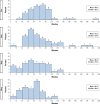The orexin antagonist SB-649868 promotes and maintains sleep in men with primary insomnia
- PMID: 22851805
- PMCID: PMC3397789
- DOI: 10.5665/sleep.1996
The orexin antagonist SB-649868 promotes and maintains sleep in men with primary insomnia
Abstract
Study objectives: To assess the acute effects of SB-649868 in male subjects with Primary Insomnia with regard to (1) objective and subjective sleep parameters, (2) safety and tolerability, (3) next-day residual effects.
Design: Multicenter, randomized, double-blind, placebo-controlled crossover study using a complete set of Williams orthogonal Latin Squares
Setting: 9 sleep centers in Germany
Patients: 52 male subjects with a diagnosis of primary insomnia (difficulty in sleep initiation and maintenance) confirmed by polysomnography
Interventions: SB-649868 (10, 30, 60 mg) and placebo administered after dinner 90 minutes before bedtime
Measurements and results: Sleep effects assessed by polysomnography during 2 consecutive nights and by sleep questionnaires completed by subjects after each night at the sleep laboratory. Safety and tolerability were assessed by adverse events collection, electrocardiogram (ECG), vital signs, laboratory tests. Next-day residual effects were assessed by Digit Symbol Substitution Test, and modified Verbal Learning Memory Test administered at "lights on" after night 2. SB-649868 significantly reduced latency to persistent sleep, wake after sleep onset (WASO), and increased total sleep time (TST) compared to placebo. A dose-dependent effect was observed. A dose-dependent increase in absolute and percent REM sleep and reduction in REM sleep latency was observed mainly at the 60-mg dose. SB-649868 was well tolerated with inconsistent next day residual effects. SB-649868 sleep effects were correlated with SB-649868 circulating levels.
Conclusion: The data demonstrate the sleep-promoting properties of the orexin antagonist SB-649868 in male patients with insomnia.
Keywords: Orexin; SB-649868; hypocretin; insomnia; polysomnography.
Figures
References
-
- Roth T, Coulouvrat C, Hajak G, et al. Prevalence and perceived health associated with insomnia based on DSM-IV-TR; International Statistical Classification of Diseases and Related Health Problems, Tenth Revision; and Research Diagnostic Criteria/International Classification of Sleep Disorders, Second Edition criteria: results from the America Insomnia Survey. Biol Psychiatry. 2011;69:592–600. - PubMed
-
- Winsky-Sommerer R. Role of GABAA receptors in the physiology and pharmacology of sleep. Eur J Neurosci. 2009;29:1779–94. - PubMed
-
- Ferguson SA, Rajaratnam SM, Dawson D. Melatonin agonists and insomnia. Expert Rev Neurother. 2010;10:305–18. - PubMed
-
- Tsujino N, Sakurai T. Orexin/hypocretin: a neuropeptide at the interface of sleep, energy homeostasis, and reward system. Pharmacol Rev. 2009;61:162–76. - PubMed
Publication types
MeSH terms
Substances
LinkOut - more resources
Full Text Sources
Other Literature Sources
Medical


